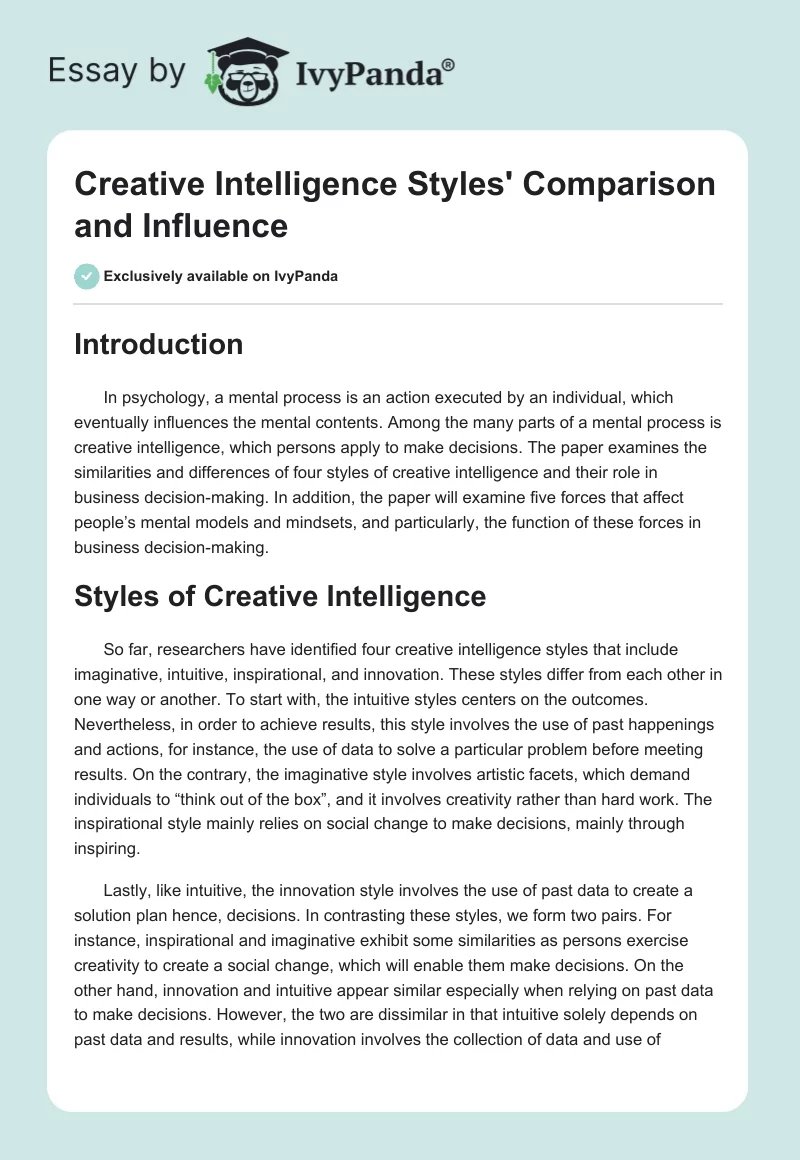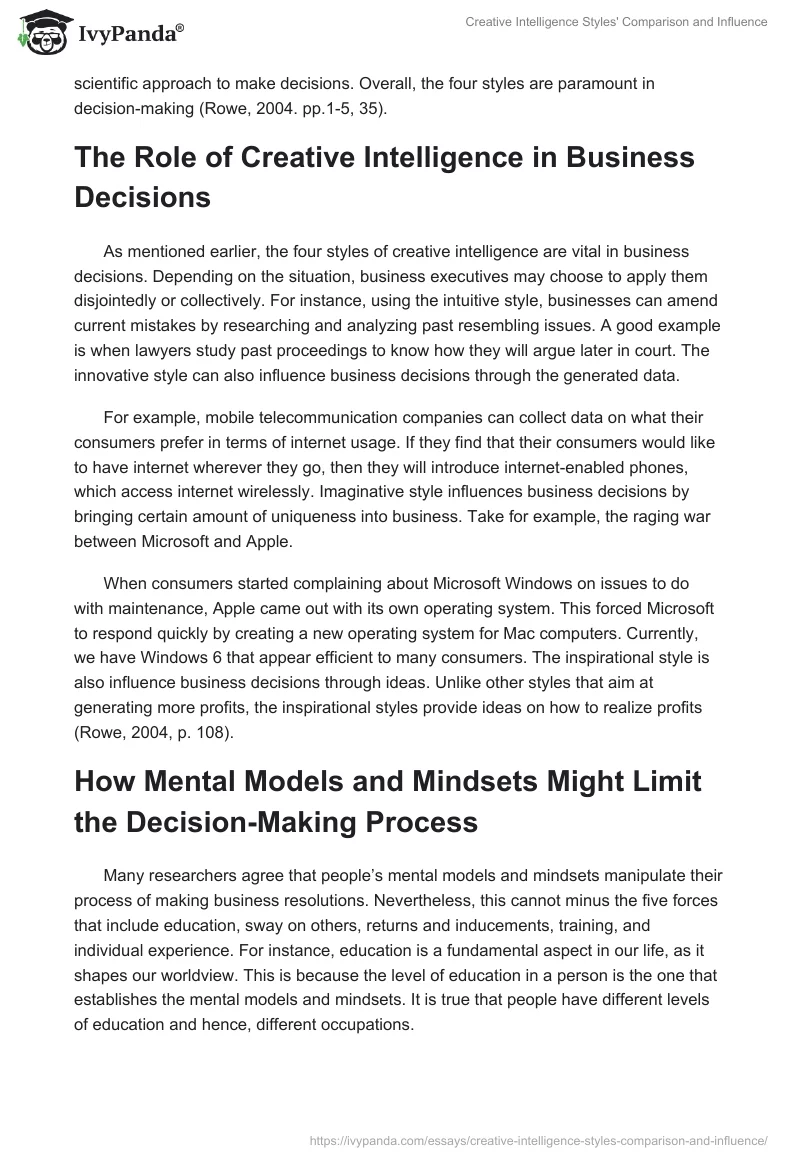Introduction
In psychology, a mental process is an action executed by an individual, which eventually influences the mental contents. Among the many parts of a mental process is creative intelligence, which persons apply to make decisions. The paper examines the similarities and differences of four styles of creative intelligence and their role in business decision-making. In addition, the paper will examine five forces that affect people’s mental models and mindsets, and particularly, the function of these forces in business decision-making.
Styles of Creative Intelligence
So far, researchers have identified four creative intelligence styles that include imaginative, intuitive, inspirational, and innovation. These styles differ from each other in one way or another. To start with, the intuitive styles centers on the outcomes. Nevertheless, in order to achieve results, this style involves the use of past happenings and actions, for instance, the use of data to solve a particular problem before meeting results. On the contrary, the imaginative style involves artistic facets, which demand individuals to “think out of the box”, and it involves creativity rather than hard work. The inspirational style mainly relies on social change to make decisions, mainly through inspiring.
Lastly, like intuitive, the innovation style involves the use of past data to create a solution plan hence, decisions. In contrasting these styles, we form two pairs. For instance, inspirational and imaginative exhibit some similarities as persons exercise creativity to create a social change, which will enable them make decisions. On the other hand, innovation and intuitive appear similar especially when relying on past data to make decisions. However, the two are dissimilar in that intuitive solely depends on past data and results, while innovation involves the collection of data and use of scientific approach to make decisions. Overall, the four styles are paramount in decision-making (Rowe, 2004. pp.1-5, 35).
The Role of Creative Intelligence in Business Decisions
As mentioned earlier, the four styles of creative intelligence are vital in business decisions. Depending on the situation, business executives may choose to apply them disjointedly or collectively. For instance, using the intuitive style, businesses can amend current mistakes by researching and analyzing past resembling issues. A good example is when lawyers study past proceedings to know how they will argue later in court. The innovative style can also influence business decisions through the generated data.
For example, mobile telecommunication companies can collect data on what their consumers prefer in terms of internet usage. If they find that their consumers would like to have internet wherever they go, then they will introduce internet-enabled phones, which access internet wirelessly. Imaginative style influences business decisions by bringing certain amount of uniqueness into business. Take for example, the raging war between Microsoft and Apple.
When consumers started complaining about Microsoft Windows on issues to do with maintenance, Apple came out with its own operating system. This forced Microsoft to respond quickly by creating a new operating system for Mac computers. Currently, we have Windows 6 that appear efficient to many consumers. The inspirational style is also influence business decisions through ideas. Unlike other styles that aim at generating more profits, the inspirational styles provide ideas on how to realize profits (Rowe, 2004, p. 108).
How Mental Models and Mindsets Might Limit the Decision-Making Process
Many researchers agree that people’s mental models and mindsets manipulate their process of making business resolutions. Nevertheless, this cannot minus the five forces that include education, sway on others, returns and inducements, training, and individual experience. For instance, education is a fundamental aspect in our life, as it shapes our worldview. This is because the level of education in a person is the one that establishes the mental models and mindsets. It is true that people have different levels of education and hence, different occupations.
Therefore, the manner in which a person, say a mechanic, views things is not the same as what the doctor perceives. With education, persons can have divergent opinions emanating from different perspectives, and hardly pose limits to the decision making process. Training on its part involves a precise sway on our decision-making process. However, unlike education, training is narrow and can be an appalling influence to the decision-making process if at all an individual is unwilling revolutionize training to fit the ever-changing environment (Rowe, 2004, pp. 89-91).
For example, training becomes a barrier to creative intelligence if persons to expand their knowledge and work outside their scope of training. When people influence others to perform a certain task, they feel highly motivated. Thus, the people around us can make can influence our mental models and mindsets on how to achieve success in business. This particular force heightens our mental models and mindsets and straightens our decision making process.
In other circumstances, definite individual mental models and mindsets end up being returns and inducements, which reflect our thinking capacity. Lastly, our personal experience can be a great influence to our decision making process if only we are ready to learn from it. In fact, this is the primary force behind the establishment of our mental models and mindsets, as we learn from past mistakes to mold a better future. Downgrading ourselves as uncreative due to experience will affect our creative intelligence. Instead, our past mistakes should be a weapon towards achieving success (Wind, Crook, Gunther, 2005, pp. 5-43).
Conclusion
In order to achieve success in anything, we should have strong perceptions that emanate from our creative intelligence and decision-making process but we should understand that it is through our styles of creative intelligence that develops our mental models and mindsets, which enable us to make vital decisions, either in business of in daily life.
Reference List
Rowe, A. (2004). Creative Intelligence: Discovering the Innovative in Ourselves and Others. London: FT Press.
Wind, Y., Crook, C. & Gunther, R. (2005). The power of impossible thinking: Transform the business of your life and the life of your business. Saddle River, New Jersey: Pearson Education.


